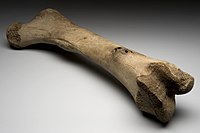
Photo from wikipedia
INTRODUCTION In the era of precision medicine, quantitative applications of x-ray Computed Tomography (CT) are on the rise. These require accurate measurement of the CT number, also known as the… Click to show full abstract
INTRODUCTION In the era of precision medicine, quantitative applications of x-ray Computed Tomography (CT) are on the rise. These require accurate measurement of the CT number, also known as the Hounsfield Unit. In this study, we evaluated the effect of patient attenuation-induced beam hardening of the x-ray spectrum on the accuracy of the HU values and a strategy to correct for the resulting deviations in the measured HU values. MATERIALS AND METHODS A CIRS electron density phantom was scanned on a Siemens Biograph mCT Flow CT scanner and a GE Discovery 710 CT scanner using standard techniques that are employed in the clinic to assess the HU deviation caused by beam hardening in different tissue types. In addition, an anthropomorphic ATOM adult male upper torso phantom was scanned on the GE Discovery 710 scanner. Various amounts of Superflab bolus material were wrapped around the phantoms to simulate different patient sizes. The mean HU values that were measured in the phantoms were evaluated as a function of the water-equivalent area (Aw ), a parameter that is described in the report of AAPM Task Group 220. A strategy by which to correct the HU values was developed and tested. The variation in the HU values in the anthropomorphic ATOM phantom under different simulated body sizes, both before and after correction, were compared, with a focus on the lung and bone tissues. RESULTS Significant HU deviations that depended on the simulated patient size were observed. A positive correlation between HU and Aw was observed for tissue types that have an HU of less than zero, while a negative correlation was observed for tissue types with HU values that are greater than zero. The magnitude of the difference increases as the underlying attenuation property deviates further away from that of water. In the electron density phantom study, the maximum observed HU differences between the measured and reference values in the cortical bone and lung materials were 426 and 94 HU, respectively. In the anthropomorphic phantom study, the HU difference was as much as -136.7 ± 8.2 HU (or -7.6% ± 0.5% of the attenuation coefficient, AC) in the spine region, and up to 37.6 ± 1.6 HU (or 17.3% ± 0.8% of AC) in the lung region between scenarios that simulated normal and obese patients. Our HU correction method reduced the HU deviations to 8.5 ± 9.1 HU (or 0.5% ± 0.5%) for bone and to -6.4 ± 1.7 HU (or -3.0% ± 0.8%) for lung. The HU differences in the soft tissue materials before and after the correction were insignificant. Visual improvement of the tissue contrast was also achieved in the data of the simulated obese patient. CONCLUSIONS The effect of a patient's size on the HU values of lung and bone tissues can be significant. The accuracy of those HU values was substantially improved by the correction method that was developed for and employed in this study.
Journal Title: Medical physics
Year Published: 2018
Link to full text (if available)
Share on Social Media: Sign Up to like & get
recommendations!